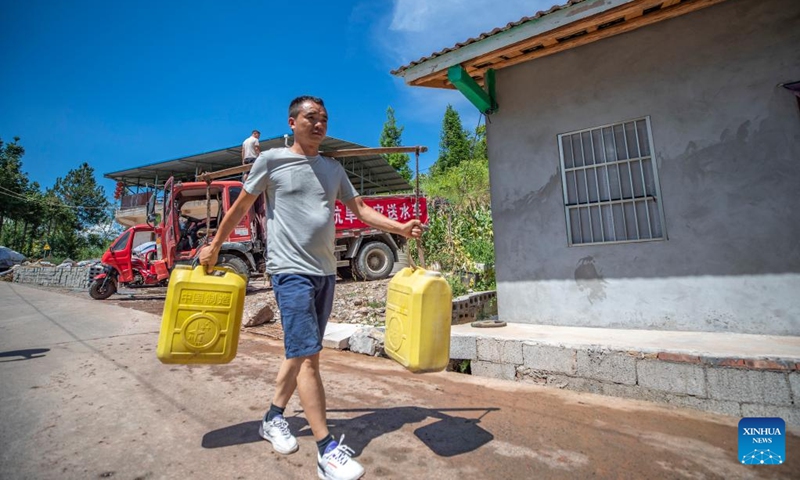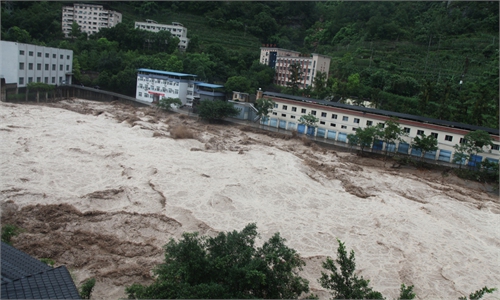China experiences four heatwaves in June, with high temperature days recorded more often and earlier than usual

A staff member fetches water for housebound villagers in Luoping Village of Wushan County, southwest China's Chongqing, Aug. 13, 2022. Persistent heatwaves have led to drought in parts of Wushan County. Authorities have increased efforts to better manage water resources for drought relief and ensure water supply for locals. (Xinhua/Huang Wei)
China experienced four heatwaves this June, with high temperature days recorded more often and earlier than usual. This has resulted in drought in multiple places due to high temperature and little rain.
China Meteorological Administration reflected on the national weather and climate characteristics in June and forecasted the climate trend and released disaster prevention and mitigation recommendations for July on Tuesday.
According to the administration, the climate in June showed prominent warm and dry climate features, with the national average temperature at 21.1 C, higher than average usual temperature by 0.7 C, and came as the second highest in history since 1961, only lower than and 21.3 C in June of 2022. Meanwhile, the national average precipitation in June was 86.7 millimeters, less than the usual average by 15.6 percent, the least in precipitation since 2005.
In June, China experienced four regional high temperature processes. The first regional high temperature process for this year happened between May 28 and June 5, 16 days earlier than usual, with its major affected areas covering Shanghai as well as Yunnan, Sichuan, Anhui and Guangdong provinces. Over 70 meteorological stations in Yunnan recorded high temperatures breaking through the historical extremes.
The strongest heatwave of this year occurred between June 21 and 30, with the municipalities and provinces including Beijing, Tianjin, Hebei, Shandong and Henan suffering extreme high temperatures. A total of 22 meteorological stations recorded historic high temperatures.
The heatwave resulted in the rapid development of drought in the northern areas. Besides, Yunnan experienced the strongest drought in winter and spring since 1961, which has been relived with obvious more precipitation since June 9.
Whereas in June, the meteorological drought has developed rapidly in the southeast of Inner Mongolia, the central and western parts of Northeast China, the north part of North China and so on due to high temperature and little rain.
The administration also noted that a total of four rainstorms occurred in China since June with the precipitation in the southern part of Central China, the southern part of East China, the central and western part of South China, and the eastern part of Southwest China experiencing precipitation reaching 50 millimeters to 100 millimeters.
The administration also released the forecast of climate trends for July. In terms of precipitation, it is expected that the main raining areas in the next 10 days between July 4 and 13 will be in places including Huanghuai, Jianghan, Jianghuai, Jiangnan North, Sichuan Basin, western and southern parts of Yunnan, with the cumulative precipitation of about 50 millimeters to 90 millimeters and some areas of 100 millimeters to 150 millimeters, or even more than 200 millimeters.
In terms of temperature, it is expected that between July 5 and 7, the eastern part of North China, Fenwei Plain, the northern part of Henan and the northern part of Shandong will experience high temperatures of 35 C to 38 C, and the daily maximum temperatures in some areas can reach 39 C to 41 C.
It is expected that in July, the temperature in most parts of the country will be close to that of the same period of the year to higher than usual. The temperatures in the places including the central and western part of Inner Mongolia, the western part of Liaoning, Beijing, Tianjin, Hebei, Shanxi, the central and northern part of Shaanxi, the southern part of Fujian, Taiwan, Guangdong will be 1 to 2 degrees higher than usual.
According to China’s National Climate Center, affected by low precipitation and high temperature in the previous period, severe drought has occurred in Chifeng in Inner Mongolia and Chengde in Hebei.
Besides, the eastern part of Inner Mongolia, the western part of Jilin, the western part of Liaoning, the northeastern part of Hubei, and the northern part of Shandong have also suffered moderate to severe meteorological drought.
Global Times


